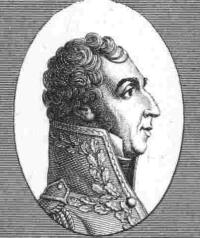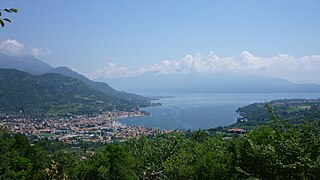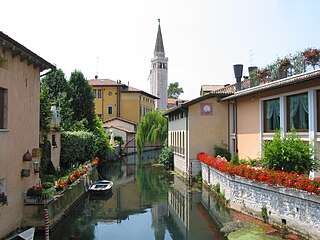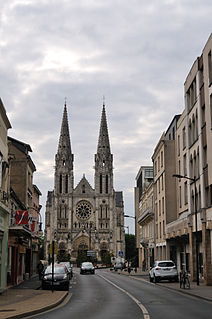
The Battle of Arcole or Battle of Arcola was a battle fought between French and Austrian forces 25 kilometres (16 mi) southeast of Verona during the War of the First Coalition, a part of the French Revolutionary Wars.

The Battle of Castiglione saw the French Army of Italy under General Napoleon Bonaparte attack an army of Habsburg Austria led by Feldmarschall Dagobert Sigmund von Wurmser on 5 August 1796. The outnumbered Austrians were defeated and driven back along a line of hills to the river crossing at Borghetto, where they retired beyond the Mincio River. The town of Castiglione delle Stiviere is located 10 kilometres (6 mi) south of Lake Garda in northern Italy. This battle was one of four famous victories won by Bonaparte during the War of the First Coalition, part of the Wars of the French Revolution. The others were Bassano, Arcole, and Rivoli.

The Battle of Bassano was fought on 8 September 1796, during the French Revolutionary Wars, in the territory of the Republic of Venice, between a French army under Napoleon Bonaparte and Austrian forces led by Count Dagobert von Wurmser. The engagement occurred during the second Austrian attempt to raise the Siege of Mantua. It was a French victory, however it was the last battle in Napoleon's perfect military career as two months later he would be defeated at the Second Battle of Bassano, ending his victorious streak. The Austrians abandoned their artillery and baggage, losing supplies, cannons, and battle standards to the French.

The Battle of Montenotte was fought on 12 April 1796, during the French Revolutionary Wars, between the French army under General Napoleon Bonaparte and an Austrian corps under Count Eugène-Guillaume Argenteau. The French won the battle, which was fought near the village of Cairo Montenotte in the Kingdom of Sardinia-Piedmont. The modern town is located in the northwestern part of Italy. On 11 April, Argenteau led 3,700 men in several assaults against a French mountaintop redoubt but failed to take it. By the morning of the 12th, Bonaparte concentrated large forces against Argenteau's now-outnumbered troops. The strongest French push came from the direction of the mountaintop redoubt, but a second force fell on the weak Austrian right flank and overwhelmed it. In its hasty retreat from the field, Argenteau's force lost heavily and was badly disorganized. This attack against the boundary between the Austrian and Sardinian armies threatened to sever the link between the two allies. This action was part of the Montenotte Campaign.

In the Battle of Rovereto on 4 September 1796 a French army commanded by Napoleon Bonaparte defeated an Austrian corps led by Paul Davidovich during the War of the First Coalition, part of the French Revolutionary Wars. The battle was fought near the town of Rovereto, in the upper Adige River valley in northern Italy.
In the Battle of Ceva on 16 April 1796, troops of the First French Republic under Pierre Augereau fought against part of the army of the Kingdom of Sardinia-Piedmont led by General Giuseppe Felice, Count Vital. Augereau assaulted the strong defensive position without success. At the direction of the Sardinian army commander, Feldmarschal-Leutnant Michelangelo Colli, Vital withdrew on the 17th in order to avoid being trapped by a second French division.
Giovanni Marchese di Provera, or Johann Provera, born c. 1736 – died 5 July 1804, served in the Austrian army in Italy during the French Revolutionary Wars. Provera played a significant role in three campaigns against General Napoleon Bonaparte during the Italian Campaign of 1796.

During the Siege of Mantua, which lasted from 4 July 1796 to 2 February 1797 with a short break, French forces under the overall command of Napoleon Bonaparte besieged and blockaded a large Austrian garrison at Mantua for many months until it surrendered. This eventual surrender, together with the heavy losses incurred during four unsuccessful relief attempts, led indirectly to the Austrians suing for peace in 1797. The siege occurred during the War of the First Coalition, which is part of the French Revolutionary Wars. Mantua, a city in the Lombardy region of Italy, lies on the Mincio River.
Adam Bajalics von Bajaháza, also Adam Bajalić von Bajaházy or Adam Bayalitsch, entered Austrian military service and fought against Prussia, Ottoman Turkey, and France. During the 1796–1797 Italian campaign against Napoleon Bonaparte, he commanded a brigade or a division in several actions.
Pierre François Sauret de la Borie led a combat division under the command of Napoleon Bonaparte during the Castiglione Campaign in 1796. He enlisted in the French army as a private in 1756. During the Seven Years' War he fought at Hastenbeck and Rossbach. He became a first lieutenant in 1789 and a lieutenant colonel in 1792. Assigned to the Army of the Eastern Pyrenees, served with distinction during the War of the Pyrenees against Spain. He was promoted to general officer in 1793 and became one of three infantry division commanders in the field army. He led his division at Palau, Boulou, Collioure, Black Mountain, Roses, and Bascara. He transferred to the Army of Italy in 1795. Bonaparte called him a very good soldier, but unlucky. He retired from active military service in order to enter politics.

In the Battle of Castiglione on 5 August 1796, the French Army of Italy under the command of General Napoleon Bonaparte defeated an Austrian army led by Field Marshal Dagobert Sigmund von Wurmser. Castiglione and the Battle of Lonato were the major actions in a campaign which marked the first attempted relief of the Siege of Mantua. While Wurmser advanced east of Lake Garda with three columns, Peter Quasdanovich moved his column into the area west of Lake Garda. The Austrians pushed back the French forces and forced Bonaparte to raise the siege. However, the French commander massed against Quasdanovich and forced him to retreat after a week of see-saw fighting. After disposing of Quasdanovich, Bonaparte turned on Wurmser and defeated the main army also. In the sequel, the French pushed the Mantua garrison back and blockaded the city.

Mathias Rukavina von Boynograd, also Mathias Rukawina, Mathias Ruccavina, Mate Rukavina, was a Croatian general in the Habsburg Monarchy imperial army service. He joined the army in 1755 and fought against the Kingdom of Prussia, Ottoman Turkey, and the First French Republic. For most of his career he served with the light infantry from the military border with Turkey. He earned the rank of general officer during the French Revolutionary Wars, distinguishing himself at Loano. During the 1796 Italian campaign, he commanded a brigade in several battles against the French army led by Napoleon Bonaparte. He was Inhaber (Proprietor) of an Austrian infantry regiment in 1803–1804.

Claude Dallemagne started his career in the French army under the Bourbons, fought in the American Revolutionary War, rose in rank to become a general officer during the French Revolutionary Wars, took part in the 1796 Italian campaign under Napoleon Bonaparte, and held military posts during the Napoleonic Wars.

Pascal Antoine Fiorella or Pasquale Antonio, comte Fiorella became a French general officer in the French Revolutionary Wars and led a brigade during Napoleon Bonaparte's famous campaign in Italy in 1796. A Corsican by birth, he joined the French Royal Army as a volunteer in 1770 and was quickly appointed an officer. When the French Revolution broke out, he was a captain. Elected lieutenant colonel of a volunteer battalion, he fought with the Army of the Alps. Transferred to the Army of Italy, he assumed command of the 46th Line Infantry Demi-Brigade in February 1794. He fought under André Masséna at Saorgio where he was wounded. In September 1794 he earned promotion to general of brigade and led the army reserve.

The Battle of Tarvis was fought during March 21-23, 1797 near present-day Tarvisio in far northeast Italy, about 12 kilometres (7 mi) west-by-southwest of the three-border conjunction with Austria and Slovenia. In the battle, three divisions of a First French Republic army commanded by Napoleon Bonaparte attacked several columns of the retreating Habsburg Austrian army led by Archduke Charles, Duke of Teschen. In three days of confused fighting, French divisions directed by André Masséna, Jean Joseph Guieu, and Jean-Mathieu-Philibert Sérurier succeeded in blocking the Tarvis Pass and capturing 3,500 Austrians led by Adam Bajalics von Bajahaza. The engagement occurred during the War of the First Coalition, part of the French Revolutionary Wars.
























